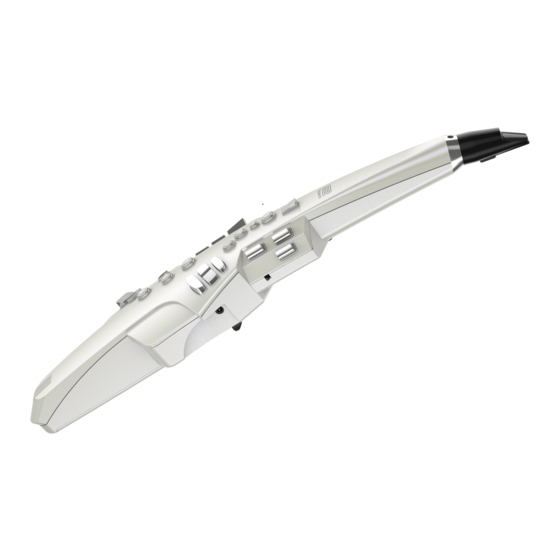Table of Contents
Advertisement
Aerophone AE-10
Owner's Manual
New digital wind instrument to expand the musical realm of saxophone players.
Saxophones are popular in all music scenes all over the world, from jazz, classical to rock
and so on. And now, Roland is introducing a new digital wind instrument, developed with
the latest technology, but designed based on the traditional acoustic saxophone. You can
enjoy playing the sounds of different saxophones from soprano, alto, tenor and baritone,
other wind instruments such as clarinet, flute and trumpet, strings instruments such as
violin, and even powerful synth leads, offering the sax players the new musical expression
and creativity.
Not only the volume but also the sound itself is dynamically affected by the force with
which you blow into the mouthpiece and the strength with which you bite it, providing a
natural and richly expressive sound.
It can be played using the same fingering as a saxophone, so if you're a saxophone player,
you'll be able to start playing after you've read a few pages of this manual. It's compact,
and can also be used with headphones, so you can enjoy playing to your heart's content
even on your living room sofa, without being concerned about the time or place.
We hope that the Aerophone will spark your imagination and enrich your musical life.
Contents
Before using this unit, carefully read "USING THE UNIT SAFELY" and "IMPORTANT NOTES" (the leaflet "USING THE UNIT SAFELY" and the Owner's Manual (p. 10)) After reading,
keep the document(s) where it will be available for immediate reference.
2
3
4
4
4
4
4
5
5
5
6
6
6
6
7
7
7
7
7
7
7
7
7
7
7
7
7
7
8
8
8
8
8
8
8
9
9
9
9
9
10
10
10
10
1
Advertisement
Table of Contents

Summary of Contents for Roland AE-10
-
Page 1: Table Of Contents
Saxophones are popular in all music scenes all over the world, from jazz, classical to rock and so on. And now, Roland is introducing a new digital wind instrument, developed with the latest technology, but designed based on the traditional acoustic saxophone. You can... -
Page 2: Panel Descriptions
Panel Descriptions Mouthpiece Performance keys This is the Aerophone’s dedicated mouthpiece. These keys are used for performance. They allow performance using & For details, refer to “Embouchure” (p. 4). the same fingering as a saxophone (p. 4). & For details, refer to “Fingering Chart” at the end of this manual. 5 When you’re not playing, protect this with the included mouthpiece cap. -
Page 3: Connecting Your Equipment
Panel Descriptions Display section Water drain Displays the tone name and menu. Drops of water will exit here. Wipe them off with a soft cloth. Tone name/ Built-in speakers [MENU] button Menu item [C] [A] buttons You mainly adjust the volume by the force of your breath while Tone number/ playing, but you can also adjust the volume in the menu (p. -
Page 4: Playing Saxophone Tones
Playing Saxophone Tones Holding the Aerophone Pressing the Performance Keys Attach the neck strap, put the strap around your neck, and hold the These are the performance keys. You can perform using the same Aerophone as shown in the illustration. fingering as on a saxophone. -
Page 5: Selecting A Saxophone Tone
[TONE] button Behavior Modeling Technology Not only physical modeling of the instruments, Roland takes it a step further by modeling the instrument’s distinctive behavior that responds to how the performer plays, resulting in true-to-life, expressive sounds in realtime. -
Page 6: Menu Settings
Menu Settings Making Settings in the Menu Saving a Tone Items indicated by the symbol in “Menu List” (p. 7) are “tone Tone name/ [MENU] button settings. ” If you want to save the tone settings, save them as a user Menu item tone as described below. -
Page 7: Menu List
Menu Settings Menu List 2: Tone Setting S: System Setting Menu Value Default Explanation Adjusting the Volume 0–10 Volume You generally adjust the volume by the strength of your breath when performing, but you can also set the volume in the menu. -
Page 8: Thumb Controller Toggle Settings
Menu Settings Menu Value Default Explanation Thumb Controller Toggle Settings Depends Specifies whether to toggle the thumb controller (left/right). Left Tgl OFF, ON on the RightTgl Normal controller operation. tone Switch to the maximum value or minimum value each time you move the controller. Octave Key Setting You can set the octave keys to either ±2 octaves or ±3 octaves. -
Page 9: Bite Sensor Center Adjustment
Menu Settings Menu Value Default Explanation Bite Sensor Center Adjustment This lets you adjust the normal state of the bite sensor (which detects the strength with which you bite the mouthpiece). Typically, you’ll set this to “AUTO” so that the sensitivity is adjusted automatically when the power is turned on. If you want to adjust it manually, proceed as follows. -
Page 10: Appendix
* This document explains the specifications of the product at the time that the document was issued. For the latest information, refer to the Roland website. • When placing this instrument on the surface of a desk or table, take care that the surface is not scratched. - Page 11 Fingering Chart / 運指表 A#3/B ² 3 C#4/D ² 4 D#4/E ² 4 F#4/G ² 4 G#4/A ² 4 A#4/B ² 4 C#5/D ² 5 D#5/E ² 5 Oct Key: OCT 1 F#5/G ² 5 G#2/A ² 3...
- Page 12 Fingering Chart / 運指表 Playing harmonics (overtones)/フラジオ奏法 F#5/G ² 5 G#5/A ² 5 G#5/A ² 5...
- Page 13 Fingering Chart / 運指表 A#5/B ² 5 A#5/B ² 5 A#5/B ² 5...
- Page 14 Fingering Chart / 運指表 D#6/E ² 6 C#6/D ² 6 D#6/E ² 6...















